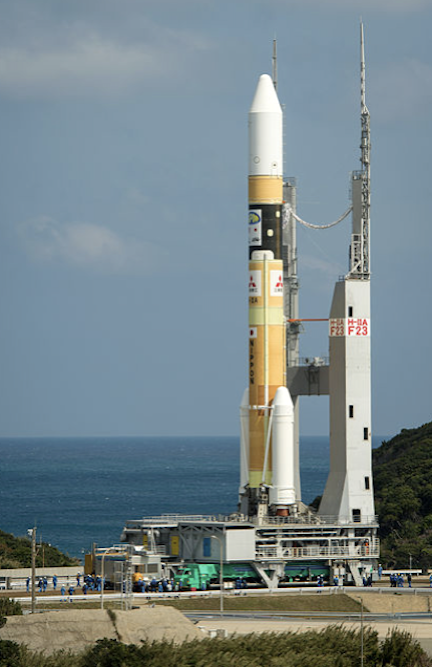February 25, 2020: On February 9th Japan launched another spy satellite using one of its own H-2A SLVs (satellite launch vehicle). With this new satellite in orbit, Japan has two digital camera photo satellites and five radar satellites operational. Japan is in the process of expanding its spy satellite fleet to ten photo and radar satellites. Japan has long been a major producer of satellites and SLVs but the spy satellites are relatively recent.

The H-IIA No. F23
Japan launched its first satellite in 1970 and became the fourth nation (after Russia, America and France) to do so. For decades Japan mainly launched scientific satellites. In the late 1990s Japan, alarmed at the threat of attack by North Korea, began developing and launching military satellites. The first two were launched in 2003, the third in 2006 and the fourth in 2007. Japan continues to build and launch photo, radar ELINT (electronic intelligence) satellites. While Japan buys some launcher and satellite tech from foreign nations (mainly the U.S.) Japan has become quite proficient and self-sufficient in both areas.
By 2010 the cameras onboard Japanese photo satellites could make out objects as small as one meter (39 inches) in diameter. By 2013 a new Japanese photo satellite could detect objects .6 meters (two feet) in size. The best U.S. spy satellites can make out much smaller objects, but for Japan's needs, .6-1 meters was adequate. The radar satellites provide all-weather coverage.
Technically, the satellites are in violation of a 1969 Japanese law, which mandated Japan only use space for non-military purposes. To get around this these satellites are technically non-military and are not controlled by the military. Japan had long refrained from launching military satellites but this changed when North Korea fired a ballistic missile over Japan in 1998. Japan promptly set out to get eight surveillance satellites in orbit by 2006, in order to keep an eye on North Korean nuclear weapons and ballistic missile efforts. This proved impossible to do. While two Japanese satellites were launched in early 2003, another two were destroyed during late 2003, when the rocket malfunctioned.
Japan had long relied on commercial photo satellites and whatever they could get from the Americans. But for high-resolution shots, on-demand, of North Korea, and electronic eavesdropping from space, they needed their own spy satellites. It is believed that Japanese spy satellites are also being used to watch military developments in China and Russia.
The Japanese program has cost over three billion dollars so far. Much of this was spent to develop SLVs large and reliable enough for satellite work. The latest launch was the 35th successful launch for the H-2A, which has a 97.5 percent success rate. The similar H-2B SLV has carried out ten successful launches. Japanese SLVs have put nearly a hundred satellites into orbit since 1970. Most have been non-military and several were for other nations. Japanese SLVs are locally designed and manufactured. These rockets operate from a launch complex in southern Japan.
The two-stage H-2A was first used in 2001. It was originally a 285 ton rocket that could put 10 tons into orbit. Later versions of the H-2A weighed up to 445 tons with a max payload of 15 tons. The H-2B variant weighs 531 tons and can put 16.5 tons into orbit.
A new SLV, the 574 ton H-3 is in development and close to entering service. The first test launch will be in 2020. The H-3 will specialize in putting satellites in high orbits. Because of the breakthroughs, American firm SpaceX has made with their reusable (they land under their own power after launch) rockets Japan is now working on an H-4 SLV that would have that feature.The Japanese photo satellites weigh about a ton, while the radar one weighs about a third more. The United States provided a lot of technical assistance on the design and construction of the satellites initially and Japan now builds its own rockets to launch them. Like most spy satellite users, Japan does not report on how effective they are. It is known that Japan could get more detailed photos from commercial satellites. But those are not controlled by the Japanese government.
From StrategyPage

